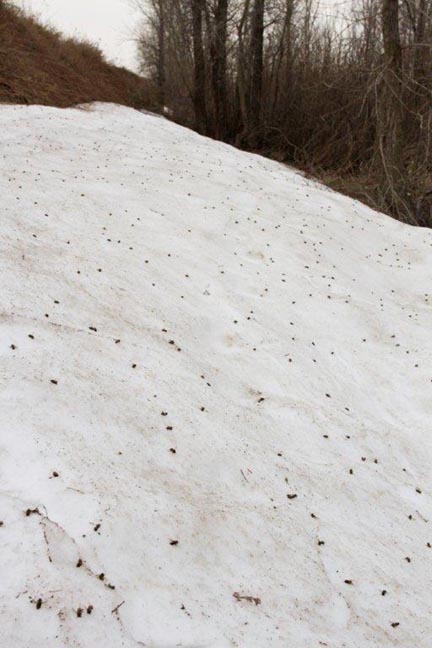In the face of increasing criticism of their handling of pesticide registration the EPA has defended its conduct with a barrage of propaganda, the most recent examples being the misleadingly named “Pollinator Summit,” more a farm show to address only one aspect of damage caused by neonicotiniods, bee kills from corn dust, and now we’ve been entertained by the announcement of a document which is supposedly the work product of a stakeholders meeting on honey bee health held seven months ago, suspiciously released to coincide with the European Union decision on a two year ban of three neonicotinoids. Despite the avalanche of scientific evidence, EPA attributes the disastrous bee losses being experienced to everything but pesticides.
These propaganda efforts are an old bureaucratic ploy, intended to create a paper trail that gives the illusion that something is being done when it isn’t, so if they (the EPA) are subjected to scrutiny, say by a Congressional Inquiry, they can point to their public proclamations and tireless efforts to address the questions. Unchallenged this sleight of hand, this twisting of the science and outright lies become fact in the minds of the uninformed and this is exactly what they are trying to accomplish.
But let’s look beyond the propaganda, beneath the surface, because what the EPA and the USDA are saying seems plausible unless you dig a little deeper. What has the EPA actually done in the face of what may well be one of the greatest environmental disasters of our time?
THE WORDS:
“We are working aggressively to protect bees and other pollinators from pesticide risks…” – EPA
THE DEED:
In the summer of 2012 EPA granted what is called a Section 18, which allowed “emergency” use on over one million acres in 4 southeastern states, to a systemic product called sulfoxaflor. While not a neonicotinoid, many scientists believe it should be classified in that family since it targets the same neural receptors as the neonicotinoids. The announcement came as a surprise to beekeeping leaders such as the National Honey Bee Advisory Board, who had been meeting with the EPA in Washington regularly, at considerable expense to themselves, in what the EPA likes to tout as “collaborative efforts”. That collaboration apparently doesn’t extend to any discussions of the EPA’s plans for sulfoxaflor, nor did they advise beekeepers that they planned to press for a conditional registration of sulfoxaflor despite serious unanswered questions as to its safety, a repeat of their disastrous performance on clothianidin. Ironically, sulfoxaflor was being pushed in response to the resistance of insects to clothianidin, approved for cotton just 2 years prior under the cloud of the failed life cycle study and the infamous “leaked memo.” They may be “working aggressively” but it hardly seems that those efforts are directed toward protecting pollinators.
As a footnote, as I was writing this the EPA announced that they had granted full registration to sulfoxaflor, foregoing conditional registration and the criticism it would undoubtedly generate. Might as well be hung for a pig as a pork chop I guess.
THE WORDS:
“We will continue to lead efforts to ensure pollinators are protected from pesticides …” – EPA
THE DEED:
Just how do they demonstrate that leadership?
When we were in California’s Central Valley to pick up a load of packages (bees), we saw mile after mile of flooded rice fields. Rice spends much of its growing life in this flooded condition. In 2012 the EPA approved both seed treatment and foliar application of the neonicotinoid clothianidin on rice. Their reasoning was that rice was of no interest to bees. Remember, however, clothianidin is water soluble, migrates with the groundwater, accumulates with successive uses, lasts for years, can be drawn up by non-target plants, and tiny amounts can have profound effects, in fact since the effect on the neural receptors is cumulative and irreversible, there is no safe dose, however small. Why not just put it right into the water system? Sure, that’ll work.
And what about bees and rice? It appears that rice has the same relation to bees as corn. It is wind pollinated, but because it is, it must produce pollen in abundance and bees exploit that pollen source. Japan has had serious bee kills from the use of clothianidin on rice, a fact that is readily available in the literature, but which seems to have escaped the EPA in what they like to call their “science driven decision making.” When Japanese scientists evaluated the pollen loads of foragers in these bee kills they found that those were 68% rice pollen, another bit of science that seems to have conveniently escaped the notice of the EPA, which concluded that rice would not present a problem since “bees don’t visit rice.” The Central Valley of California is reporting significant water contamination from systemic pesticides. In 2012 the State of California reported that imidacloprid, another neonicotinoid, had been found in 89% of surface water samples from agricultural areas. Would it be reasonable to expect the same results with clothianidin? Of course it would.
Do not be duped by the words, the EPA is doing everything they can to deny the science and cover their tracks for to admit to anything will bring their house of cards tumbling down and reveal years of bad decisions.

